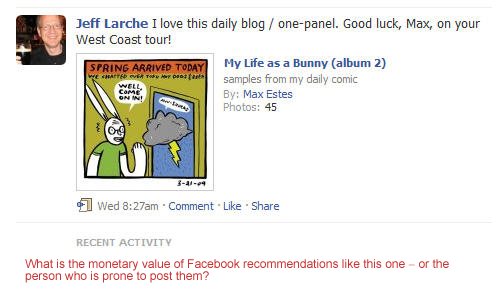Is someone who blabs about a brand on Facebook or another social network site any more valuable to a retailer than the passive “fan” of that product? And if yes, what is that new value? This was discussed at an Email Insider Summit earlier this week. It’s an important question. But as panelists used the format to think aloud, they began confusing two phenomena. One is the real-but-weak power of social network influence. The other is the strong-but-possibly-nonexistent “Gladwellian” Maven.
Malcolm Gladwell’s The Tipping Point talked about Mavens as hubs of influence. These folks are strong connections in a social ecosystem. As mavens on this subject or that, their opinion means much in persuading others. Gladwell based much of his book on the research by Duncan J. Watts, described in his book Six Degrees of Separation: The Science of a Connected Age.

This research, which was itself predicated on Stanley Milgram’s small world experiment, suggested that strong ties do most of the work in spreading a message.
The only catch: When the actual pathways were traced in Watts’ experiment, he found that only 5% of the work was actually done by these supposed hubs. He finally concluded that messages can be spread nearly as efficiently without hubs (i.e., Gladwell’s Mavens), and in fact, these myriad weak connections are the key to a social network’s real power to influence.
Can I Endorse Some Tupperware?
The marketers on the panel at the Summit should have kept this in mind. If MediaPost reported their collective thoughts correctly, they were crowded together on thin ice indeed. According to the MediaPost account (free registeration required), “They agree that a person who simply visits a ‘fan’ page and is a static follower is of minimal value. But people who can be tagged as influencers — who forward information to friends or other contacts that result in transactions — have tremendous value.”
When I first read this, my thought was, “Sure, of course people who refer other people to a brand and get them to buy are valuable.” But it sounds like the power of a pass-along is being highly overvalued. Continuing from this account of the discussion:
Email marketers are working hard on algorithms to quantify the worth of those influencers operating via social media outlets. Tim Schigel of ShareThis.com, who spoke on a panel at the MediaPost Email Insider Summit on Wednesday, said: “We’ll see a better understanding of that (soon) … the industry is trying to figure it out.”
Also on the panel was Craig Swerdloff, CEO of LeadSpend, who said the value of a social-media influencer should be “another variable that you put into your algorithm to determine the lifetime value of a customer.”
What is that amount? A back-of-the-envelope calculation could be as follows: If a Netflix customer is worth $9 alone, but that person has 500 Facebook friends, and is able to drive even 1% of them (5) to make a purchase, that individual’s value could be as high as $54.
Yow! That $54 would confer my full value in Netflix’ eyes to everyone else who also becomes a Netflix subscriber. I see the following flaws with even approaching such a calculation:
- Lifetime value is a predictive number. It’s a break-even cost of finding someone else to replace me if I should stop using Netflix. That value was probably calculated over a year’s worth of use of the service — probably more. Could these five friends each be as loyal from Day One? And if we waited a year, would I be able to cough up five more Facebook friends who join the service?
- How can my friends’ association with me — or even their consideration of an endorsement I send their way — be given credit for their conversion into customers? Are they not Facebook friends of other people who are fans or active ambassadors for the brand? I would guess that they are. And if so, do I get full credit just because I messaged these five about the service? What about the force of these weak connections? Are these many mutual friends who are fans worth nothing?
The value equation being discussed certainly works if I was actively recruiting and selling for a pyramid marketing business (example: “How’d you like to host a Tupperware party and keep half the profits?”) But for something as passive as “You should consider this product,” it would be hard to value an active Maven much higher than the passive fan.
Maybe not any higher at all.
In a world where many weak connections can trump a few strong ones, a better value equation may be an aggregate of all passive fans — where they are also Mavens or not.
 To kick things off in 2008, I’m thrilled to bring you an interview with Michael Beddows, CEO of the new
To kick things off in 2008, I’m thrilled to bring you an interview with Michael Beddows, CEO of the new